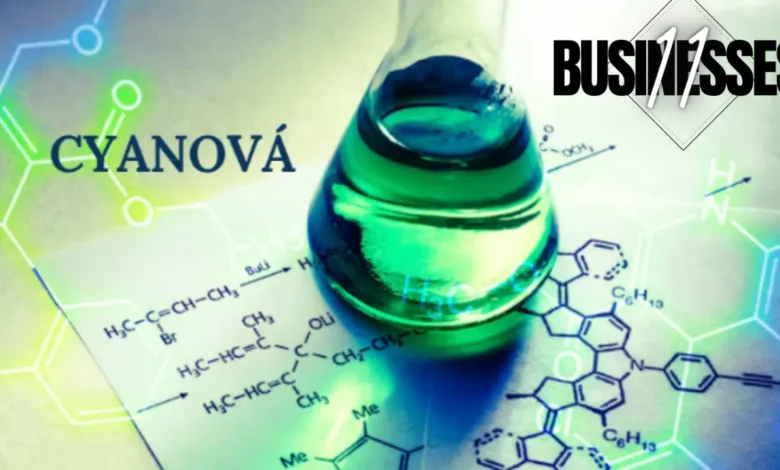Understanding Cyanová: Its Role and Impact Across Various Fields

Cyanová is a striking blue-green color that has made a significant impact in numerous areas, including art, technology, chemistry, and marketing.
Known for its vibrant and refreshing appearance, It is more than just a visual element; it plays a crucial role in creating captivating designs, enhancing technological interfaces, and contributing to chemical processes.
This article explores the multifaceted uses and benefits of cyanová, providing insights into how this color influences our world and its applications in different industries.
What is Cyanová?
Cyanová is a term that relates to a unique color and its uses in various industries. This bright and vivid shade of blue-green can be found in many applications, from design and technology to chemistry and art.
Understanding the significance of It can help in appreciating its role and impact in different fields.
How is It Used in Art and Design?
It is a popular color in art and design due to its vibrant and eye-catching nature. Artists and designers use It to create striking visuals and evoke specific emotions.
In graphic design, this color can enhance the aesthetic appeal of digital and print media. Its bright tone helps in drawing attention and making designs stand out.
The use of It in art can range from painting to digital graphics. Artists might choose this color to represent themes of tranquility and freshness. In design, it can be used to create modern and innovative looks.
The versatility of It makes it a valuable asset in visual creativity.
What Role Does It Play in Technology?
In technology, It is used in various ways. It is a standard color in screens and displays, thanks to its vibrant appearance. It can be seen in LED lighting and electronic displays, where it helps in creating bright and clear images.
It is also important in printing technology. It is one of the primary colors in the CMYK color model, which is used for color printing.
This model combines It, magenta, yellow, and black to produce a wide range of colors. Its role of in this model is crucial for achieving accurate and high-quality prints.
How is It Utilized in Chemistry?
It, a distinctive blue-green color, is involved in various chemical applications and processes. Its utilization spans from basic chemical reactions to more complex industrial applications. Understanding how It is used in chemistry can shed light on its importance and versatility.
What Chemical Compounds Contain It?
It is associated with several chemical compounds, particularly those used as dyes and pigments.
One notable example is cyan blue, a pigment used in art and industrial applications. This pigment is produced through a chemical reaction involving compounds such as copper phthalocyanine.
Copper phthalocyanine is known for its brilliant cyan color and stability, making it a popular choice in inks, paints, and coatings.
Another important compound is the cyanide ion, which contains the It color but is primarily known for its chemical reactivity.
Cyanide compounds, like sodium cyanide and potassium cyanide, are used in various industrial processes, including gold extraction and electroplating. While these compounds are highly reactive and require careful handling, they are crucial in certain chemical applications.
How Does It Play a Role in Chemical Reactions?
Its compounds often participate in chemical reactions that are essential for producing various products. For instance, in organic synthesis, It derivatives can be used as intermediates in the creation of complex molecules.
These reactions can involve the formation of new chemical bonds or the modification of existing structures.
In analytical chemistry, compounds can be used as indicators in tests. For example, certain It dyes are employed in colorimetric assays to determine the concentration of specific substances. The color change observed during these tests provides valuable information about the chemical composition of a sample.
What Are the Applications of It in Industrial Chemistry?
In industrial chemistry, It is used in several key applications. One significant use is in the production of dyes and pigments for textiles, plastics, and other materials.
The bright and stable nature of Its pigments makes them ideal for creating vibrant colors in a wide range of products.
It is also involved in electroplating processes. Electroplating is a technique used to apply a thin layer of metal onto a surface.
Its compounds can be part of the electrolyte solutions used in this process, helping to achieve a smooth and even coating.
How Does It Affect the Environment?
While It has many useful applications, it is important to consider its environmental impact. Some It compounds, particularly those that contain cyanide, can be harmful if not managed properly.
In industrial processes, strict regulations are in place to ensure that cyanide and other potentially hazardous substances are handled safely to prevent environmental contamination.
In general, the use of It in chemistry requires careful consideration of safety and environmental factors.
When managed correctly, the benefits of It in various applications can be substantial, contributing to advancements in technology and industry.
What are the Benefits of It in Everyday Products?
It is a color that brings several benefits to everyday products. Its bright and fresh appearance makes it a popular choice for consumer goods, including clothing, home decor, and packaging. Products in It often stand out on shelves and attract attention.
In addition, It is associated with a sense of calm and clarity. This makes it a favored color for products designed to promote relaxation and well-being. The presence of It in everyday items can contribute to a pleasant and engaging experience for users.
How is It Used in Environmental Design?
In environmental design, It is used to create spaces that feel refreshing and vibrant. This color can be applied in various ways, such as in landscaping, interior design, and public spaces. It helps to create environments that are visually appealing and harmonious.
For instance, It can be used in water features and outdoor areas to evoke a sense of freshness. In interior design, it can be applied to create a calm and inviting atmosphere.
The use of It in environmental design contributes to creating spaces that are both functional and aesthetically pleasing.
What Impact Does It Have on Marketing and Branding?
It plays a significant role in marketing and branding. Its distinctive and vibrant nature helps brands stand out and create a memorable image.
Many companies use It in their logos and branding materials to attract attention and convey specific messages.
The impact of It in marketing is evident in various industries. It helps brands to differentiate themselves and create a strong visual identity.
The use of this color can influence consumer perception and contribute to the overall success of marketing campaigns.
What are the Pros and Cons of Using It?
Here’s a table outlining the benefits and potential drawbacks of using It:
| Pros | Cons |
| Vibrant and eye-catching | May not suit all design themes |
| Creates a sense of freshness | Can be overpowering if overused |
| Enhances visual appeal | Limited in some cultural contexts |
| Effective in attracting attention | May clash with certain colors |
It is a versatile color that offers many benefits in design, technology, chemistry, and everyday products.
Its vibrant nature makes it a powerful tool in various fields, though it is important to use it thoughtfully to maximize its impact.
FAQs
What is It?
It is a vivid blue-green color that is used in various fields such as art, technology, and chemistry. It is known for its bright and eye-catching appearance.
How is It Used in Art and Design?
In art and design, It is used to create visually striking and appealing works. It enhances designs by adding a vibrant touch, making visuals stand out and attract attention.
Why is It Important in Technology?
It is important in technology as it is used in screens, displays, and printing processes. It helps in creating clear and bright images in electronic devices and contributes to accurate color reproduction in printing.
What Role Does It Play in Chemistry?
In chemistry, It is used in dyes, pigments, and various chemical reactions. It helps in producing certain substances and testing reactions, highlighting its versatility in chemical applications.
How Does Cyanová Benefit Everyday Products?
Cyanová adds a fresh and vibrant look to everyday products like clothing and home decor. It is associated with calmness and clarity, enhancing the appeal and functionality of consumer goods.
What is the Impact of Cyanová in Environmental Design?
Cyanová is used in environmental design to create refreshing and aesthetically pleasing spaces. It can be applied in landscaping and interior design to evoke a sense of tranquility and visual harmony.
How Does Cyanová Affect Marketing and Branding?
In marketing and branding, cyanová helps brands stand out with its distinctive color. It creates a memorable visual identity and can influence consumer perception, making it a valuable tool in brand design.
Conclusion
Cyanová is a dynamic and versatile color with a wide range of applications across different fields. From its use in art and technology to its role in chemistry and environmental design, It enhances visual appeal and functionality.
Understanding the benefits and potential drawbacks of this color can help in making informed choices about its use in various contexts.
Whether it’s for creating vibrant designs, improving technological interfaces, or contributing to branding efforts, cyanová continues to make a significant impact in our world.





